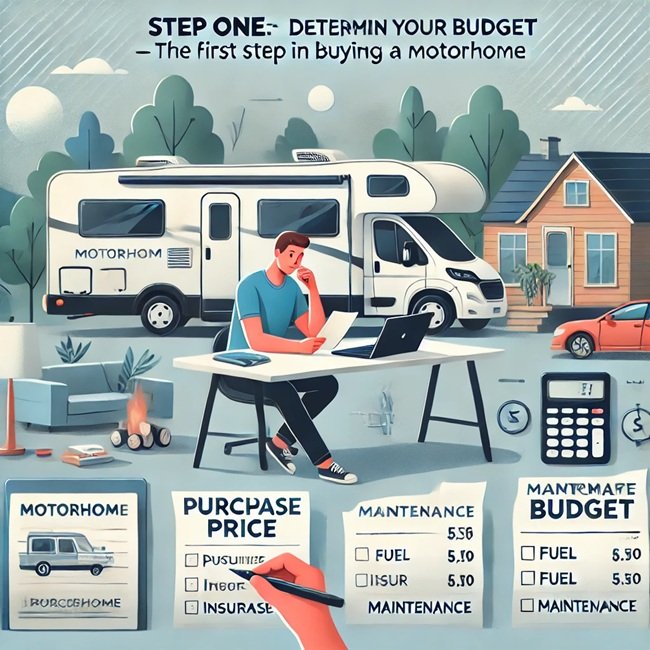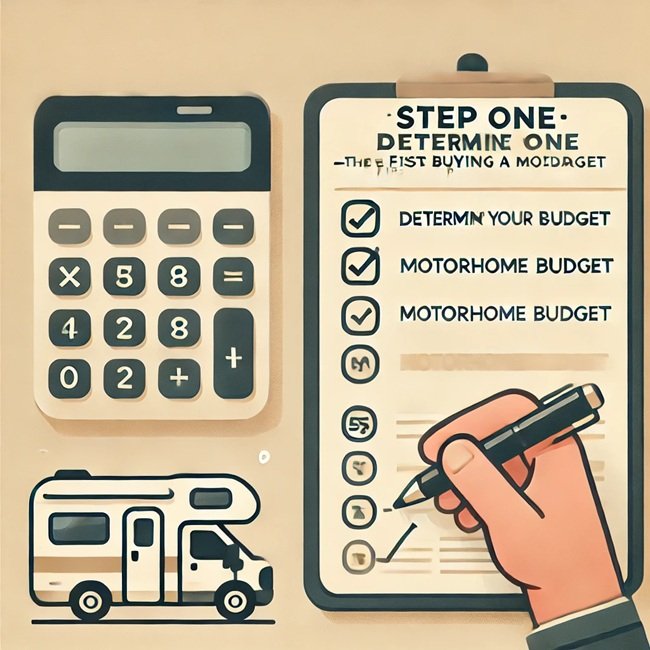Buying a motorhome is a significant financial commitment, and the first step in making a well-informed decision is to establish a realistic budget. Many first-time buyers focus primarily on the purchase price, but owning a motorhome involves many ongoing costs that need to be considered to avoid financial strain later on. Whether you are considering a brand-new motorhome with all the latest features or a well-maintained used model, understanding the full financial picture is essential.
This article will guide you through the key financial factors you need to consider before purchasing a motorhome. By the end of this step, you will have a clear understanding of how much you can afford to spend and what costs you need to plan for beyond the initial purchase.

Understanding the True Cost of a Motorhome
The cost of a motorhome varies significantly based on factors such as size, type, brand, and features. New motorhomes generally range from £50,000 to over £200,000, while used motorhomes can be purchased for a fraction of that price. However, it’s important to recognize that the initial purchase price is only part of the overall cost of ownership.
A common mistake buyers make is underestimating the long-term costs associated with running and maintaining a motorhome. These costs can quickly add up and should be factored into your budget from the beginning.
New vs. Used Motorhomes: How They Impact Your Budget
One of the biggest financial decisions when buying a motorhome is whether to purchase a new or used model. Each option comes with its own advantages and cost considerations.
Buying a New Motorhome
A brand-new motorhome provides the peace of mind that comes with a manufacturer’s warranty, no previous wear and tear, and the latest features in comfort and technology. However, it also comes with a hefty price tag.
-
Pros:
- Full manufacturer’s warranty covering defects and repairs.
- No previous owners, meaning no hidden damage or wear.
- Customization options to fit your exact preferences.
- Latest technology, safety features, and fuel efficiency.
-
Cons:
- High initial cost, which may require financing.
- Rapid depreciation—new motorhomes lose 20% of their value within the first year and up to 50% within five years.
- Higher insurance costs due to the vehicle’s value.
Buying a Used Motorhome
A used motorhome can be a smart financial decision, offering significant cost savings while still providing a great travel experience. However, it requires thorough inspection and research to ensure you don’t end up with costly repairs.
-
Pros:
- Lower purchase price—often 30% to 50% less than a new model.
- Slower depreciation compared to a new motorhome.
- Many used motorhomes come with added extras like solar panels or upgraded appliances.
-
Cons:
- No manufacturer’s warranty unless a third-party extended warranty is purchased.
- Potential wear and tear that could lead to costly repairs.
- Limited availability of specific layouts or features.
Breaking Down the Costs of Ownership
Once you’ve decided between new and used, you need to budget for the additional costs that come with owning a motorhome. These include:
1. Insurance Costs
Motorhome insurance varies based on factors such as vehicle age, value, storage location, and driving history. On average, annual insurance costs range from £300 to £1,500. New motorhomes tend to have higher premiums due to their greater value. If buying used, check if the previous owner had any claims, as this can impact future insurance costs.
2. Road Tax and Registration Fees
Motorhome taxation is based on weight, emissions, and type. While road tax is generally lower than for cars, it’s still a recurring expense that needs to be considered. Registration fees also apply when transferring ownership of a used motorhome.
3. Maintenance and Repairs
Routine maintenance is necessary to keep your motorhome in top condition. This includes servicing the engine, checking tires, maintaining plumbing and electrical systems, and preventing damp or water leaks. The average annual maintenance cost is between £500 and £2,000, but unexpected repairs can be much higher.
New motorhomes may have fewer initial repair costs but often require expensive servicing once out of warranty. Used motorhomes may need immediate servicing or part replacements depending on their condition.
4. Fuel Consumption and Costs
Motorhomes are not fuel-efficient compared to regular vehicles. The average fuel economy is between 15 and 25 mpg, meaning that long-distance travel can be expensive. The cost of fuel will depend on your travel frequency and distance, so it’s important to factor this into your budget.
5. Campsite and Hookup Fees
If you plan to stay in motorhome parks or campsites, expect to pay between £10 and £50 per night for a pitch with electricity, water, and waste disposal facilities. Over time, these costs add up, particularly if you travel frequently.
For those looking to save money, wild camping is an option, though this may require additional investment in solar panels and off-grid power sources.
6. Storage Costs
If you don’t have space to park your motorhome at home, you may need to pay for secure storage. Storage costs vary by location and range from £30 to £150 per month.
7. Depreciation and Resale Value
Understanding depreciation is crucial when budgeting for a motorhome. New models lose value quickly, while used ones hold their value better. If you plan to upgrade in the future, consider how much your motorhome will be worth when you decide to sell it.
Financing Your Motorhome Purchase
If you don’t plan to buy your motorhome outright, financing is an option. Many dealers offer finance plans with interest rates between 5% and 10% APR. Monthly payments should fit within your budget, ensuring you can comfortably afford the loan over its term.
Consider alternative financing methods such as personal loans or remortgaging if interest rates are more favorable. However, be mindful of long-term costs and ensure the repayment terms suit your financial situation.
How to Set a Realistic Budget
To determine how much you can afford, follow these steps:
- Calculate your total available funds – Include savings and any potential financing.
- Estimate the purchase price – Decide if you’re buying new or used.
- Factor in annual ownership costs – Include insurance, maintenance, fuel, and campsite fees.
- Plan for unexpected expenses – Set aside an emergency repair fund.
- Compare finance options – Ensure monthly payments are manageable if taking a loan.
Final Thoughts
Determining your budget is the foundation of a successful motorhome purchase. It ensures that you not only afford the vehicle itself but also manage the ongoing costs associated with ownership. Taking the time to assess your financial situation, explore new vs. used options, and plan for hidden expenses will help you make a confident and informed decision.
By establishing a well-thought-out budget, you set yourself up for a smooth and enjoyable motorhome ownership experience. In the next article, we will explore Step Two: Assessing Your Travel Needs, where we will help you determine what features, size, and layout will best suit your lifestyle and adventures.
Finally, check out: The Ultimate 8-Step Guide to Buying a Motorhome: New vs. Used

2 thoughts on “Step One: Determine Your Budget – Buying a Motorhome”